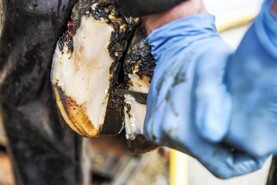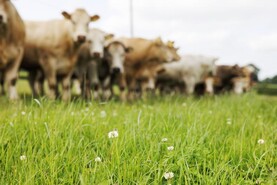Infectious lameness in sheep can pose a significant burden to farmers due to its potential negative impact on flock performance, increased veterinary costs alongside its welfare impact on infected animals.
There are three types of infectious lameness, namely: interdigital dermatitis (scald), footrot and contagious ovine digital dermatitis (CODD).
A research project being undertaken by Teagasc in conjunction with the School of Veterinary Medicine and the School of Agricultural and Food Science in University College Dublin is seeking to investigate the presence of lameness on Irish farms through a national farmer survey.
On-farm factors
The completion of this survey by farmers will allow us to determine the on-farm factors that are associated with increasing or decreasing amounts of lameness on farms and establish the levels of which the different types of infectious lameness are present at farm level in Ireland.
So far, over 350 responses have been gathered from farmers all over the country and some preliminary results to date include:
A higher proportion of lowland farmers compared to upland and hill farmers reported seeing infectious lameness conditions on their farms.Over half of farmers surveyed so far have reported to having a case of CODD on their farms in the past year, indicating it may now be commonplace on Irish sheep farms.Over a quarter of all farmers surveyed so far reported not to footbath their sheep.
Jake Delaney, Teagasc.
The past weeks have seen milder weather developing across the country.
This, coupled with occasionally damp conditions and increased grass growth, can put flocks, (particularly young lambs) at risk to the occurrence of scald.
Scald, which has the ability to spread rapidly within the flock if left untreated, presents as red inflammation between the digits of the hoof which can be accompanied by a white/yellow discharge.
Footbathing, when used correctly, can be an effective method of preventing and treating cases of scald in ewes and lambs.
Footbathing is most effective when sheep remain in the footbath for 15 to 20 minutes when using a 10% zinc or copper sulphate-based solution followed by at least 30 to 60 minutes where sheep stand on a dry, hard surface to allow the footbathing solution to dry into the hoof. The use of a batch footbath allows for these longer standing times and the treatment of many animals together without stalling or slowing the handling process.
To date, over 90% of survey respondents have reported seeing a case of scald on their farm in the past year, with the highest scald burden being reported by respondents between June and August annually. The use of an antibiotic aerosol spray and footbathing was reported by farmers as the two most common treatments utilised to combat cases of scald but answers have varied.
As scald can spread from sheep to sheep during close contact, it is important where sheep are gathered in confined spaces for prolonged periods of time, such as in the handling yard that sheep are passed through the footbath on exit from the handling unit. This acts as a key disinfection point, limiting the spread/development of scald and other conditions.
There is also growing evidence that the control and prevention of scald reduces the incidence of footrot and CODD where the causative bacteria is already present on farm.
If you would like to add your experiences with infectious lameness in sheep and help us to improve our knowledge on how farmers manage infectious lameness in Irish sheep flocks, then there is still time to complete the survey here.
The survey will take approximately 10 minutes to complete and it focuses on several areas such as the lameness conditions farmers see and the management methods which they apply to prevent, control and treats cases of lameness on the farm.
Over 50% of farmers surveyed to date have recorded CODD on their farms. Footbathing, when used correctly, can be an effective method of treating and preventing scald. It is important where sheep are gathered in confined spaces to pass through the footbath on exit from the handling unit.
Infectious lameness in sheep can pose a significant burden to farmers due to its potential negative impact on flock performance, increased veterinary costs alongside its welfare impact on infected animals.
There are three types of infectious lameness, namely: interdigital dermatitis (scald), footrot and contagious ovine digital dermatitis (CODD).
A research project being undertaken by Teagasc in conjunction with the School of Veterinary Medicine and the School of Agricultural and Food Science in University College Dublin is seeking to investigate the presence of lameness on Irish farms through a national farmer survey.
On-farm factors
The completion of this survey by farmers will allow us to determine the on-farm factors that are associated with increasing or decreasing amounts of lameness on farms and establish the levels of which the different types of infectious lameness are present at farm level in Ireland.
So far, over 350 responses have been gathered from farmers all over the country and some preliminary results to date include:
A higher proportion of lowland farmers compared to upland and hill farmers reported seeing infectious lameness conditions on their farms.Over half of farmers surveyed so far have reported to having a case of CODD on their farms in the past year, indicating it may now be commonplace on Irish sheep farms.Over a quarter of all farmers surveyed so far reported not to footbath their sheep.
Jake Delaney, Teagasc.
The past weeks have seen milder weather developing across the country.
This, coupled with occasionally damp conditions and increased grass growth, can put flocks, (particularly young lambs) at risk to the occurrence of scald.
Scald, which has the ability to spread rapidly within the flock if left untreated, presents as red inflammation between the digits of the hoof which can be accompanied by a white/yellow discharge.
Footbathing, when used correctly, can be an effective method of preventing and treating cases of scald in ewes and lambs.
Footbathing is most effective when sheep remain in the footbath for 15 to 20 minutes when using a 10% zinc or copper sulphate-based solution followed by at least 30 to 60 minutes where sheep stand on a dry, hard surface to allow the footbathing solution to dry into the hoof. The use of a batch footbath allows for these longer standing times and the treatment of many animals together without stalling or slowing the handling process.
To date, over 90% of survey respondents have reported seeing a case of scald on their farm in the past year, with the highest scald burden being reported by respondents between June and August annually. The use of an antibiotic aerosol spray and footbathing was reported by farmers as the two most common treatments utilised to combat cases of scald but answers have varied.
As scald can spread from sheep to sheep during close contact, it is important where sheep are gathered in confined spaces for prolonged periods of time, such as in the handling yard that sheep are passed through the footbath on exit from the handling unit. This acts as a key disinfection point, limiting the spread/development of scald and other conditions.
There is also growing evidence that the control and prevention of scald reduces the incidence of footrot and CODD where the causative bacteria is already present on farm.
If you would like to add your experiences with infectious lameness in sheep and help us to improve our knowledge on how farmers manage infectious lameness in Irish sheep flocks, then there is still time to complete the survey here.
The survey will take approximately 10 minutes to complete and it focuses on several areas such as the lameness conditions farmers see and the management methods which they apply to prevent, control and treats cases of lameness on the farm.
Over 50% of farmers surveyed to date have recorded CODD on their farms. Footbathing, when used correctly, can be an effective method of treating and preventing scald. It is important where sheep are gathered in confined spaces to pass through the footbath on exit from the handling unit. 






 This is a subscriber-only article
This is a subscriber-only article











SHARING OPTIONS: